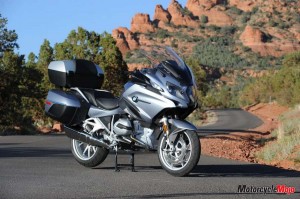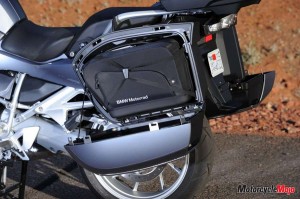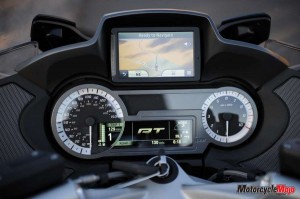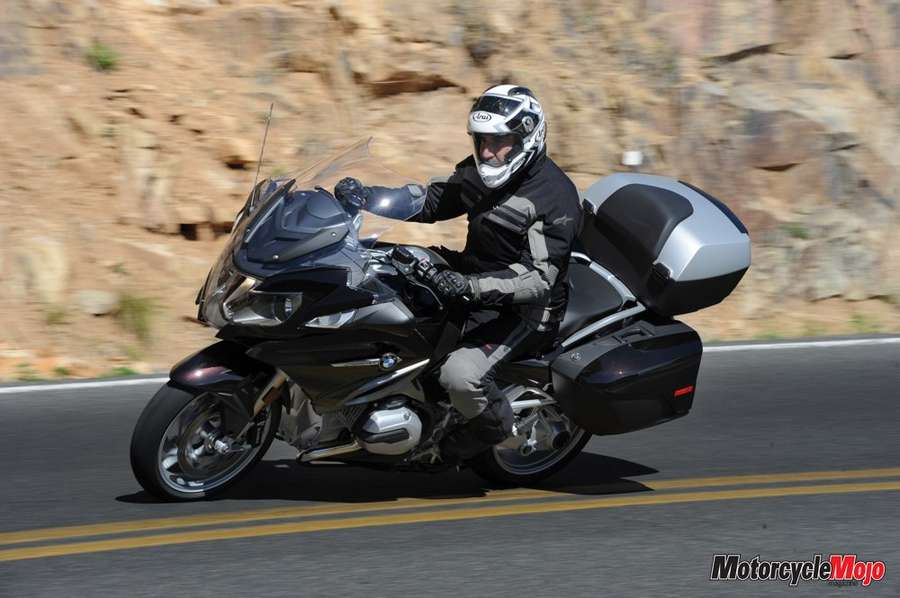Through sleet or snow, rain or shine, the RT’s weather protection sets this bike apart from the crowd
My first real experience with the BMW R1200RT was during a tour of Tuscany in 2010, hosted by Edelweiss Tours. The bike had been upgraded with BMW’s more powerful eight-valve boxer engine that year, but I had chosen it for its wind protection, and since I was travelling with my girlfriend, for its luggage capacity. What I also got in the package, quite unexpectedly, was a machine that handled like a sportbike. And the RT’s weather protection proved better than any larger luxury-touring bike I’d ridden. Even the K1300GTL, BMW’s flagship touring motorcycle, doesn’t match the RT’s wind-breaking capability. I recently renewed my relationship with the R1200RT at the press launch of the latest generation, held in the spectacular red rock canyons surrounding Sedona, Arizona.
BMW’s big adventure-touring bike, the R1200GS, got a complete overhaul last year, receiving an all-new frame, and it was the first bike to use the firm’s latest liquid-cooled boxer engine. Wait, did I confuse you? Why am I discussing BMW’s adventure-tourer when this review should be about the RT? Because once the two machines are stripped of their bodywork (which is all-new on the RT), it would be difficult to distinguish the new RT from the new GS. They share the same engine and frame, and look almost identical beneath their bodywork. But from the saddle they are unique machines, entirely different from one another.
 We stayed at the Enchantment Resort, nestled within the crimson cliff walls of Boynton Canyon, and located just a few miles north of Sedona. The clear morning sky belied the actual weather forecast, which called for snow later in the day. It was a cool morning, in the high single-digits Celsius, so after adjusting the seat to its higher of two positions for more legroom (seats 25 mm higher or 25 mm lower are available as no-cost options), the next thing I did was to turn on the RT’s standard heated grips. In an oversight on my part, I’d forgotten to pack warm gloves and would have to make do with summer gloves on this ride, which was shortened to about 240 km from the original 320 km due to the forecast snow. This was unfortunate, because the omitted section of our route would have taken us to the Lomaki ruins at Wupatki National Monument. Perhaps that’s a future road-trip location to add to my list.
We stayed at the Enchantment Resort, nestled within the crimson cliff walls of Boynton Canyon, and located just a few miles north of Sedona. The clear morning sky belied the actual weather forecast, which called for snow later in the day. It was a cool morning, in the high single-digits Celsius, so after adjusting the seat to its higher of two positions for more legroom (seats 25 mm higher or 25 mm lower are available as no-cost options), the next thing I did was to turn on the RT’s standard heated grips. In an oversight on my part, I’d forgotten to pack warm gloves and would have to make do with summer gloves on this ride, which was shortened to about 240 km from the original 320 km due to the forecast snow. This was unfortunate, because the omitted section of our route would have taken us to the Lomaki ruins at Wupatki National Monument. Perhaps that’s a future road-trip location to add to my list.
Much like Harley’s Project Rushmore big twins, BMW’s latest boxer twin applies liquid cooling only to the heads, the remaining heat being dissipated by air passing over finned cylinders. The engine is easily identifiable by the vertical configuration of its intake and exhaust, which improves airflow into the cylinders and also improves legroom, as the throttle bodies are no longer located ahead of your shins. The new engine produces 125 horsepower, which is 15 hp more than in the previous RT, which was still built around BMW’s previous-generation, air/oil-cooled boxer. But BMW didn’t just graft the new R1200GS engine into the RT. The engine has been slightly altered with a torque-enhancing, heavier flywheel (0.9 kg heavier), and it gets a more powerful, 540-watt alternator, an increase of 30 watts, which also adds some flywheel mass. These changes have also been incorporated into the 2014 R1200GS Adventure, while the standard GS gets a lighter crank and smaller alternator.
BMW purists might lament the passage of the separate gearbox and single-plate dry clutch, since the latest engine incorporates the transmission into the crankcase and uses a multi-plate wet clutch, now located behind the front engine cover. This makes it more difficult to service the transmission, though clutch access is much easier. The new engine is more compact overall, which has allowed engineers to make the bike narrower between the legs. They also made the seat 30 mm longer overall and dropped seat height by 20 mm.
 At $20,850, the R1200RT costs several thousands less than larger bikes in the class, yet offers big-bike comfort. Opting for the $1,530 Touring package adds cruise control, seat heating, Dynamic ESA and an in-dash GPS. The GPS is well integrated into the bike’s computer. Any warnings or error messages that might pop up are displayed on the GPS screen (a small warning triangle lights to grab your attention), and you can then read a description of the problem. If you choose the RT without the GPS, there’s a different visor on the dash, so you’re not left with a gaping hole or a tacky cover to conceal it. There’s also an available Comfort package that includes central locking (one button locks the saddlebags and optional top case), alarm system, tire pressure monitor, accessory socket and chrome exhaust for $935, and a Dynamic package that includes Riding Mode Pro (which retains mode settings if bike is shut off), hill start control (keeps bike from rolling on an incline) and LED headlights.
At $20,850, the R1200RT costs several thousands less than larger bikes in the class, yet offers big-bike comfort. Opting for the $1,530 Touring package adds cruise control, seat heating, Dynamic ESA and an in-dash GPS. The GPS is well integrated into the bike’s computer. Any warnings or error messages that might pop up are displayed on the GPS screen (a small warning triangle lights to grab your attention), and you can then read a description of the problem. If you choose the RT without the GPS, there’s a different visor on the dash, so you’re not left with a gaping hole or a tacky cover to conceal it. There’s also an available Comfort package that includes central locking (one button locks the saddlebags and optional top case), alarm system, tire pressure monitor, accessory socket and chrome exhaust for $935, and a Dynamic package that includes Riding Mode Pro (which retains mode settings if bike is shut off), hill start control (keeps bike from rolling on an incline) and LED headlights.
The riding position is very accommodating, though oddly, it feels like you’re sitting atop the RT rather than in it. With the standard seat in the higher position, legroom was just adequate for me, but enough so that I wouldn’t have wanted to sacrifice reach to the ground by opting for the taller seat. If you’re about 6-foot-2 or taller, you should opt for the taller seat.
The previous R1200RT fairing offered the best weather protection of any motorcycle on the market. Period. For 2014, the fairing has been redesigned and is more angular and aggressive looking, and it works even better than before. Inside the fairing, there’s a new, car-like instrument panel with round gauges mounted on either side of a high-definition TFT screen. The info displayed on the screen includes suspension settings (if the optional ESA is selected), ride mode settings, hand-grip and seat heat levels, and trip info.
The windscreen is still adjustable electrically, and you can fine-tune it to find the ideal spot – which will probably vary depending on rider height – where turbulence drops to almost nothing. Raising it higher than optimum creates a mild reverse draft, pushing you slightly forward. The fairing-mounted mirrors are also set wider apart than before, which not only provides a better rear view, but also protects your hands from the windblast. It’s the combination of dead air and heated grips that allowed me to continue through the entire ride, in temperatures that dropped to freezing, while wearing lightweight summer gloves.
 The R1200RT uses a new, one-piece tubular steel frame (formerly two parts, bolted to the front and rear of the engine) that is particularly rigid and provides assured rider feedback. The only thing lacking on the RT, or any telelever-equipped BMW, is an ability to tighten up a turning line while trail braking. It doesn’t take long to adapt to the lack of brake dive though, and you quickly learn to do all of your braking, which can be quite hard on this bike, in a straight line.
The R1200RT uses a new, one-piece tubular steel frame (formerly two parts, bolted to the front and rear of the engine) that is particularly rigid and provides assured rider feedback. The only thing lacking on the RT, or any telelever-equipped BMW, is an ability to tighten up a turning line while trail braking. It doesn’t take long to adapt to the lack of brake dive though, and you quickly learn to do all of your braking, which can be quite hard on this bike, in a straight line.
We rode open, winding roads in the morning, where the RT displayed its stellar touring capability, but the pace picked up along a wonderfully smooth stretch of pavement that clung tightly to the contours of the mountains surrounding Jerome. Here, the RT proved its handling prowess with neutral steering, exceptional stability and enough cornering clearance to make a sportbike rider smile. There are three ride modes – Rain, Road and Dynamic – and selecting Dynamic mode along this section of road provided sharp yet easily manageable acceleration, and with the ESA suspension set to hard for a solo rider, the bike carved through corners with unmistakable precision. Altogether quite an impressive display for such a large touring bike.
One feature BMW has included as optional equipment, but that’s not really necessary, is an electric quick shifter. More commonly seen on sportbikes and designed for track use, it’s meant to be used at high speeds with the throttle open to help reduce shift times, and ultimately to drop lap times. On the R1200RT, it’s uniquely designed to work when upshifting and downshifting, but its operation was clunky at lower speeds, and it raised the effort at the shift lever. I used it a few times and then resorted to old-school, clutch-assisted shifting. It did work exceptionally well at high speeds, but I still question its value on a touring bike.
After lunch in Flagstaff, the temperature dropped to freezing and the morning’s forecast came true – it began to snow. Having been caught in unexpected snowfalls twice at previous press launches, forced to abandon press bikes along the route on both of those occasions, I well understood our hosts’ urgency to make a safe yet speedy return to Enchantment Resort.
It was during this hasty retreat that the RT exhibited its true versatility. Although it was snowing hard enough that snow accumulated on the windscreen, the RT soldiered on, encasing me in a comfortable cocoon of almost still air. In these conditions, I had set the ride mode to Rain (which provides the maximum level of traction control and softens throttle response) and the suspension to soft, and rode on, worry free. By this time I’d also switched on the seat heat to the third of five settings, and was warm from head to toe (even your feet are protected by the protruding cylinders). Had the weather turned any worse, however, it would have been foolish to continue.
As we rode toward lower elevations, the snow turned to rain; we were in no less of a hurry to return, though, as the foul weather followed close behind. It was along a straight stretch of single-lane highway that journalist David Booth demonstrated, albeit unintentionally, just how forgiving the new RT chassis is. Superdave Osbooth, as he’s since been nicknamed, accelerated to just over 140 km/h to get by some slower bikes, when he hit a large rock that was resting on the centre line of the road. He hit the errant object, which was about twice the size of a softball, head on, destroying the wheels and blowing out both tires instantly. To everyone’s surprise, Booth remained upright and maintained control until he came to a stop on the shoulder.
Now, this is definitely a testament to the bike’s stability, but Booth is also a skilled rider, so he didn’t panic or make sudden movements. His elevated speed also helped in this instance, as his momentum kept the bike moving in a straight line. Despite this remarkable feat, I wouldn’t recommend trying this at home, though it’s sure nice to know that the RT won’t break in two or pitch you to the ground should you try.
We returned to the resort, safe and sound (minus one crippled RT), and despite the wintry weather, no one complained about being cold. I was still amazed that I’d completed the ride with summer gloves on, a true indication of how much effort BMW put into keeping the RT rider cosy over long distances in inclement weather.
There’s simply no other bike on the market that combines luxury-touring comfort with sportbike handling the way the R1200RT does. But what really sets this bike apart from others is its exceptional weather protection, and with the cold, wet start to the season we experienced this year, it looks like it’ll be a popular choice.



























